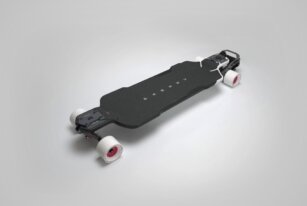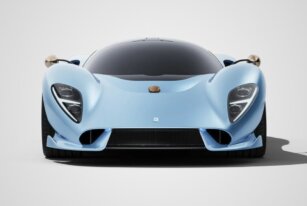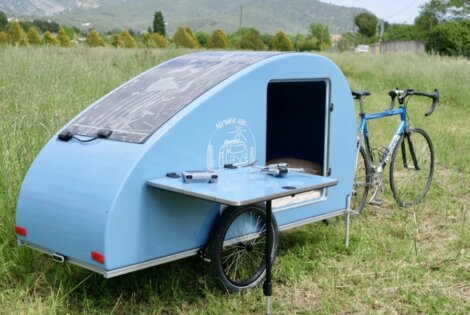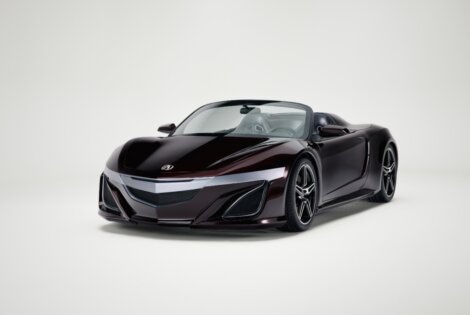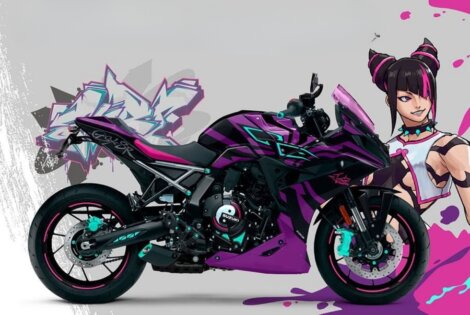Electric vehicles and hybrids are all the rage these days, so it’s no surprise that some of the top-rated luxury brands are stepping up to the trend.
Now, you won’t just find everyday-driving electric vehicles, but “supercars” that bring the best of electric power into top-of-the-line, ultra-luxe cars.
Below, we’ll take a look at the 10 fastest hybrid supercars, which combine insane horsepower with hyper-fast engines and sleek, cutting-edge interiors. The result: a truly game-changing vehicle with a high price tag, but an excellent investment for any luxury vehicle collector.
But first, before we get to our list, there are a few things you need to know about the hybrid supercars we’ll be showcasing…
A Quick Guide to Hybrid Vehicles
When we talk about “hybrid” vehicles, there is a big difference from a full electric vehicle.
You see, with an electric vehicle, the engine and motor are fully electric, with no conventional fuel (gasoline or diesel) used in the car’s propulsion. While electric vehicles are incredibly economical, they just don’t have the same power potential as a fuel engine—at least, not yet. Technology will continue to evolve, and electric vehicles will inevitably become more powerful as it does, but the current electric engines aren’t yet capable of matching the power generated by a gas engine.
For the vehicles we’ll be showcasing below, the “hybrid supercars”, there are two types most commonly referred to as hybrid:
- Plug-in hybrid. These vehicles are built with an electric battery that you charge by plugging in—usually at home, though many parking structures and charging stations around the country offer a cheap means of powering up. When charged, the battery will give you a certain amount of distance you can travel. However, after the charge runs out, the vehicle switches to its gas engine, which serves as a backup so you can drive to the next charging station.
On the “pro” side, these vehicles tend to be very economical. Typically, unless you’re driving hundreds of miles in a day, you can drive largely using the electric power in the battery, so you rarely end up using gasoline. However, on the “con” side, the battery-powered motors face the same issue that full electric vehicles do—they just don’t quite pack as much punch as a gas motor.
- Standard or “mild” hybrid. These hybrids are “gas-forward”, meaning there is a gas engine that provides most of their power. However, in addition to the gas engine, they typically feature some sort of electric-powered system—such as regenerative braking—that kicks in to add power to the gas engine or reduce fuel economy.
On the “pro” side, you get all the power of a gas engine, with the faster acceleration and higher torque of the electric system. However, on the “con” side, you use more gasoline than with a plug-in hybrid or electric vehicle. It’s less affordable to operate.
Most of the supercars below will fall into this second category, meaning they’re powered largely by gasoline engines but have some sort of electric motor to add extra “oomph” and give you greater acceleration while also reducing fuel usage.
Before we look at the list, however, there’s something else we need to discus…
What the Heck is a Supercar?
If you’re never heard the term “supercar” before, you’re not alone. Supercars aren’t very common, chiefly because they’re top-of-the-line luxury vehicles that not just anyone can afford.
There is no real definition for the term “supercar”. You’ll find the term is often used interchangeably with “muscle car”, “sports car”, and “hypercar” because of the many similarities between them.
However, there are a few key differences between these various vehicle types:
- Muscle cars tend to generate lot of power (like supercars), and they’re built for performance (also like supercars). However, unlike supercars, muscle cars are all about accelerating straight ahead. They don’t handle tight corners and sharp turns as well. They’re at their very best when roaring down a long, straight highway. Many of the cars driven in The Fast and the Furious movies are muscle cars.
- Sports cars are designed to be fast, powerful, and handle curves and turns like a beast (all features they share with supercars). However, sports cars tend to be a step down from supercars in terms of affordability. They’re at the top end of the “mid-range” in terms of cost. They are also more commonly available (unlike limited edition hypercars and supercars), and will often be used as a daily driver around town.
- Supercars are vehicles that generate a lot of power, and can take sharp turns and tight curves with the same agility as a sports car. However, they’re quite a large step above sports cars in terms of cost, which means they’re harder to afford, and are often available only in limited quantities. They’re also a bit harder to handle than sports cars, and they have a higher speed and horsepower. You typically won’t see supercars on the road because of how prized they are, and may just be too powerful to use on the average city street.
- Hypercars are a step above supercars (hence the term “hyper”) in every sense of the word. They offer better technology both inside and out, better handling, more exclusivity (due to even more limitations placed on their production), and tend to cost significantly more than the standard supercar. They’re rare and typically owned by collectors, driven only on closed race tracks or rolled out for special high-end car shows and events.
As you can see, supercars are near the top of the line, but they’re more accessible and available than hypercars. For those who can afford the best of the best, they can be a great option.
And, as you’ll discover in our list of cars below, there are a lot of spectacular hybrid supercars that can reach incredible speeds and offer breathtaking handling. Keep reading to find your next splurge car!
Top 10 Fastest Hybrid Supercars
Contents

PORSCHE 918 SPYDER
The Porsche 918 Spyder was one of the first supercars ever built using a hybrid engine, and though it dates back to 2013 (sold out by 2014), it’s still one of the top supercars on the market (when you can find a used one in great condition).
It was actually billed as a “hypercar”, capable of completing the world-famous Nürburgring track in just 6 minutes and 57 seconds. It packs an insane amount of power: a 4.6-liter V8 engine capable of generating 944lb-ft of torque and 894 horsepower. It’s got two electric engines—one on the front that produces 127 horsepower, with a rear-mounted engine capable of generating 154 horsepower—that makes for amazing handling when roaring down the track.
Though you only get about 19 miles of range on the liquid-cooled lithium-ion battery, you can rip from 0 to 60 in just over 6 seconds on electric-only mode. It definitely set the bar insanely high for all the other hybrid supercars to follow.
Specs
- Top Speed: 214 mph
- 0-60: 6.1 seconds (on electric mode)
- Engine: 4.6-liter V8
- Horsepower: 894
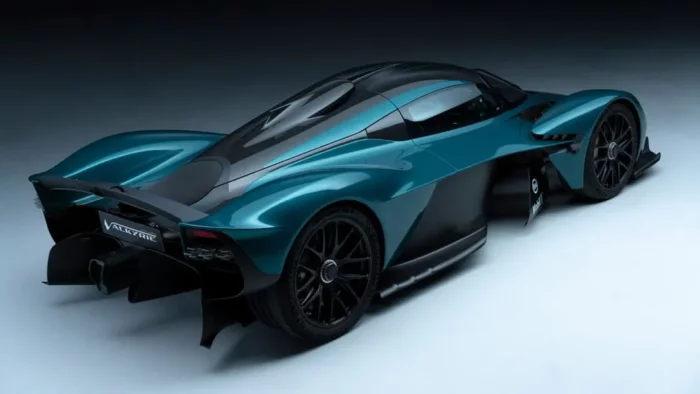
Aston Martin Valkyrie
Who wouldn’t love to drive a supercar made by the same vehicle-maker who designed and manufactured James Bond’s cars? The Aston Martin Valkyrie was built to be a “hypercar”, incorporating immense power with excellent handling and a graceful ride that will feel smooth as silk on even the roughest tracks.
Under the hood, the car packs a 6.5-litre V12 engine that, combined with its 160 horsepower electric motor, generates a whopping 900Nm of torque and a breathtaking 1,140 horsepower. Capable of hitting top speeds well over 200 miles per hour, it combines the heart-pounding speed of a hypercar with the style and luxury you’d expect from the most cutting-edge supercar.
Sure, it’s one of the priciest hypercars on our list—heck, in the world!—but given that it cango from 0 to 60 in just 2.5 seconds, it’s an absolute dream car in every sense of the word.
Specs
- Top Speed: 225 MPH
- 0-60: 2.5 seconds
- Engine: 6.5-litre V12 engine
- Horsepower: 1,140
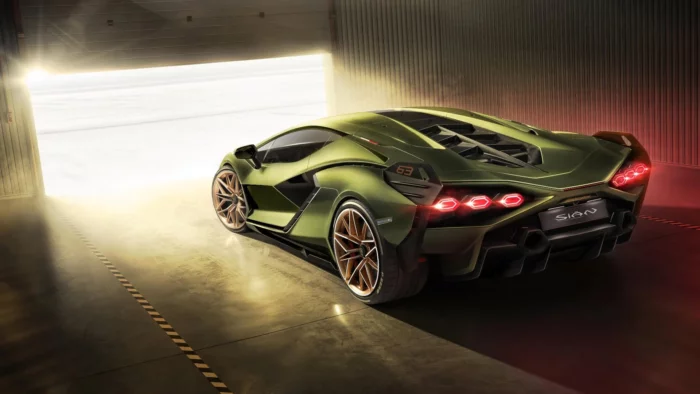
LAMBORGHINI SIÁN FKP 37
The Sián FKP 37 has the distinction of not only being Lamborghini’s most powerful supercar, but also its first hybrid car. It’s built on the design of their ultra-famous Aventador SVJ, with all the eye-catching curves and ripples that makes it every car collector’s dream vehicle. But once you get a look at what it’s packing power-wise, you’ll agree that’s where it really sets itself above the crowd.
Like the Aventador, the Sián FKP 37 comes with a V12 engine (6.5 liter), but also integrates an electric motor that, though on the smaller side, is powered by a supercapacitor that gives it plenty of oomph. When you open the engine up, it can generate a total of 808 brake horsepower, reaching speeds of 217+ MPH and going from 0 to 60 MPH in just 2.8 seconds.
What’s truly special about this car is that it’s incredibly hard to get your hands on. According to Car Magazine, Lamborghini plans to produce just 63 of this particular model before switching to one with a more conventional hybrid system. If you’ve got a few extra million lying around, this is the car for you.
Specs
- Top Speed: 217+ MPH
- 0-60: 2.8 seconds
- Engine: 6.5-liter V12
- Horsepower: 808
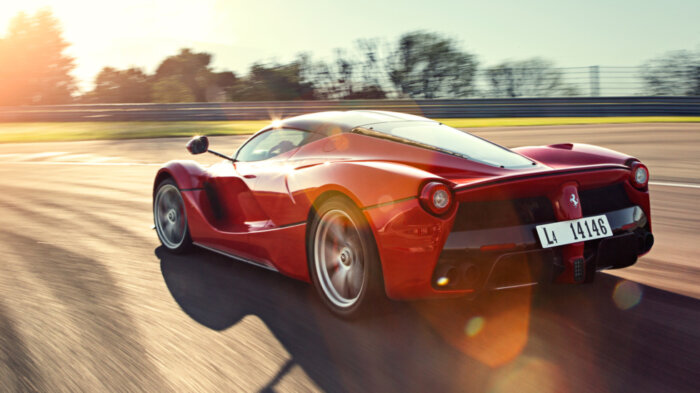
Ferrari LaFerrari
Ferrari’s LaFerrari was intended to serve as a demonstration of just how far the brand’s technology and engineering has advanced in the last decades, their crowning achievement. Hence its name, which literally translates to “The Ferrari”. Once you see just how powerful it is, you’ll agree that it definitely deserves a place on this list.
The 6.3-liter V12 is combined with a 161 horsepower electric motor, which together can produce 949 horsepower and take it up to a breathtaking 217 miles per hour. You’ll love how much speed it has right out of the gate—hit the accelerator, and you’ll go from 0 to 60 in just 2.6 seconds.
What’s unique about this car is the Kinetic Energy Recovery System, Ferrari’s proprietary tech that lets the electric motor borrow power from the hyper-powerful V12 engine, so it stays fully charged without sacrificing a single horsepower. Best of all, with the Aperta model, you can open the top and really feel what the car’s capable of as the wind blows through your hair.
Specs
- Top Speed: 217 MPH
- 0-60: 2.6 seconds
- Engine: 6.3-liter V12
- Horsepower: 949

MCLAREN SPEEDTAIL
The F1 may be the best-known of McLaren’s line of supercars, but the Speedtail is the new kid on the block that is quickly earning a reputation for being a badass. It’s actually the F1’s successor, adding improvements and upgrading the engine to give it a whole lot more zoom-power when you open it up to full speed.
The modified twin-turbo V8 engine was taken from the McLaren 720S, and connected to a parallel system electric motor that makes it a true force to reckon with. When working in tandem, the two engines can generate a mind-boggling 1,036 horsepower take you from 0 to 60 in just 2.5 seconds.
Other amazing features of this hybrid supercar include: central driver positioning, push-button windshield darkening, front-mounted HD cameras that replace your side mirrors but can be retracted when you really want to push the speed, carbon fiber static wheel covers, and hydraulically-actuated rear ailerons. But be warned: it’s definitely not a street-legal car, so use it only on your favorite speed tracks and race courses.
Specs
- Top Speed: 250 MPH
- 0-60: 2.5 seconds
- Engine: Modified twin-turbo V8
- Horsepower: 1036

KOENIGSEGG REGERA
You may not have heard of the Swedish car manufacturer Koenigsegg Automotive AB unless you live in Scandinavia or Northern Europe and can afford top-of-the-line sports cars and supercars. However, connoisseurs will know exactly what kind of quality they’re getting when they order a Koenigsegg.
The Koenigsegg Regera is a “retired” model, meaning it’s no longer being manufactured. However, if you can get your hands on one, it’s an absolute dream of a car to drive. Not only is it one of the fastest supercars around—capable of reaching speeds up to 250 MPH—but it’s insanely agile, as it demonstrated when it set the 0-400-0 KPH record in 2019 (in just 31.48 seconds).
Thanks to its dry-sump twin-turbo 5.0-litre V8 engine and the three electric motors added on for extra power, it can generate a spectacular 1,479 brake horsepower, or over 2,000 nm of torque. Instead of using a standard gearbox, it uses a direct-drive system to feed maximum power to the rear wheels, giving you more acceleration to match the amazing power.
Specs
- Top Speed: 250 MPH
- 0-60: 2.8 seconds
- Engine: Twin-turbo 5.0-litre V8 engine
- Horsepower: 1,470
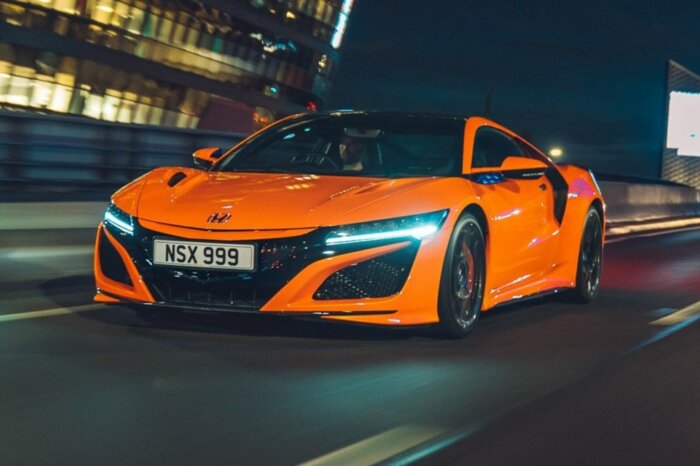
ACURA NSX
You might be surprised to see Acura on this list. After all, Acura is a brand best-known for high-end daily drivers, not necessarily supercars. Well, once you get a closer look at the NSX, you’ll agree that it definitely deserves its place here.
The car was originally announced way back in 2007, but only debuted in 2016. However, the wait proved worth it, as the NSX packed a 3.5-liter twin-turbocharged V6 plus three electric motors, all of which generated a combined total of 573 horsepower. The NSX is capable of top speeds of just below 200 MPH, roaring from 0 to 60 in 3.3 seconds. You also get surprisingly good fuel efficiency—22 mpg on the highway and 21 mpg in the city. And yes, it is rated for city driving (it’s street legal) so you can zip around town showing off your masterpiece of Japanese engineering.
One very cool feature about the NSX: it has an all-wheel-drive powertrain, with one motor to power the rear wheels and two to power each of the front wheels. That ensures it handles well and takes those sharp turns like an absolute beast. However, thanks to the built-in silencers, your car will run through city streets without all the noise that makes supercars unsuitable for in-city driving.
Specs
- Top Speed: 191 MPH
- 0-60: 3.3 seconds
- Engine: 3.5-liter twin-turbocharged V6
- Horsepower: 573
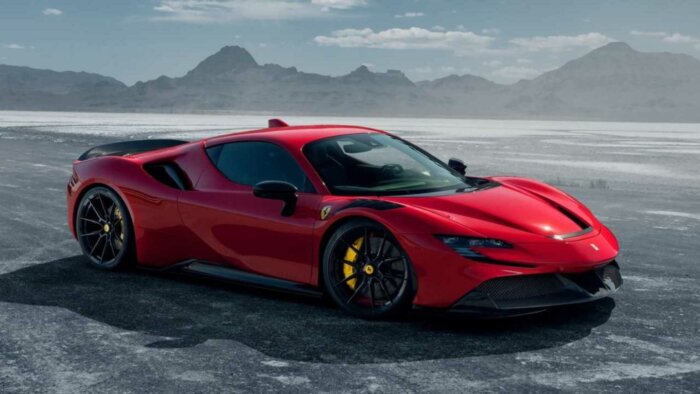
FERRARI SF90 STRADALE
You can’t go wrong driving a Ferrari supercar around town, especially one modeled after one of the most iconic Formula One cars ever to hit the road. That’s right: the SF90 Stradale shares a lot in common with the SF90, not just its name, but a mid-engine design and all-wheel-drive that gives it both excellent handling and power.
The 4.0-liter twin-turbocharged V8 engine is capable of generating up to 590lb-ft of torque and 769 horsepower, but it’s backed up by three electric motors that add on an extra 217 horsepower between them—for a total of 986 horses in all. The addition of a 7.9kWh lithium-ion battery gives it plenty of extra oomph when accelerating, plus a 15.5-mile range and top speed of 84 MPH on just electric power alone. Put it all together, though, and the car can go from 0 to 60 in 2.5 seconds and reach a spectacular top speed of 211 miles per hour.
Don’t think that this vehicle only excels on speed, though. It also handles like a dream, with superb steering even on the sharpest turns. It’s all thanks to the front-axle torque vectoring offered by the three electric motors—one mounted between the engine and transmission, the other two located on the front axle. When the time comes to rip down the highway, you’ll feel the power between your legs for sure.
Specs
- Top Speed: 211 MPH
- 0-60: 2.5 seconds
- Engine: 4.0-liter twin-turbocharged V8 engine
- Horsepower: 986
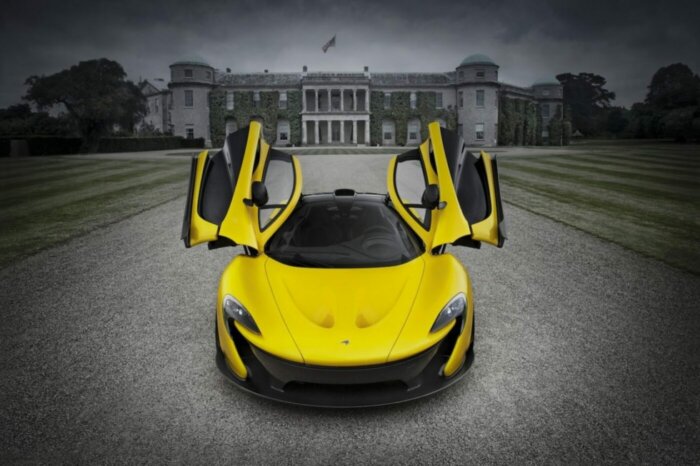
MCLAREN P1
The McLaren P1 is a true marvel of British engineering. Like the Ferrari LaFerrari and the Porsche 918, it’s considered one of the “holy trinity of hybrid supercars”, capable of death-defying feats of speed and handling that most of its rivals can only dream of. Though it’s an older-model option than the new-and-improved McLaren Speedtail, the classic supercar can still very much hold its own on any course.
Beneath the hood, you’ve got a twin-turbocharged V8 engine that’s capable of generating 727 horsepower, plus an extra electric motor to add 177 horsepower extra—for a total of 904 horses pulling in sync. But rather than relying on its electric motor to take it up to speed, the P1 uses its Instant Power Assist System to use the electric motor to merely fill the “gaps” in the gas engine’s turbo. The effectiveness of this design is proven in its performance—it can go from 0 to 60 in just 2.8 seconds, which was impressive for the early 2010s when this car was first designed.
The P1 also brings in some of the features that makes McLaren’s some of the best Formula One cars around, including Drag Reduction System rear wing to increase straight-line speed and a KERS to maximize efficiency. The result is a truly exceptional supercar that any collector would be proud to own.
Specs
- Top Speed: 217 MPH
- 0-60: 2.8 seconds
- Engine: Twin-turbocharged V8 engine
- Horsepower: 904
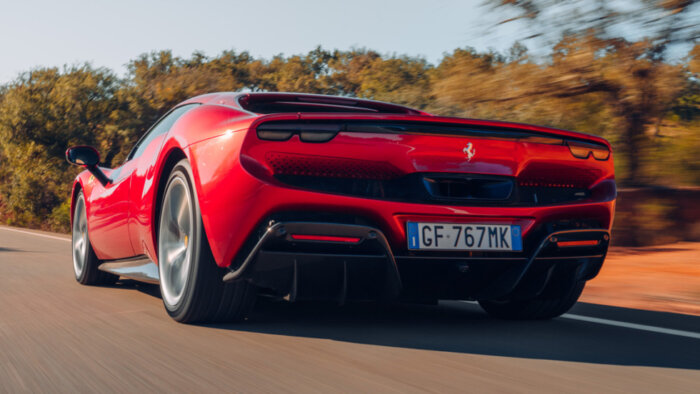
Ferrari 296 GTB
Just because we saved the Ferrari 296 GTB for last, that doesn’t at all mean it’s the “least”. Far from it, in fact! The Ferrari 296 GTB is one of the best entry-level supercars, combining a more affordable price tag with plenty of power and a design that will dazzle your eyes and delight your car-lover’s heart.
Instead of the V8 used by many of the more powerful Ferrari models, the Ferrari 296 GTB packs a twin-turbocharged V6 hybrid. As the first 6-cylinder engine in a road car since 1974, it definitely has a lot to prove, and does so in style by producing a tremendous 819 brake horsepower. Once you push it, it’ll go from 0 to 62 MPH in just 2.9 seconds, and can reach top speeds upwards of 200 MPH with ease.
The fact that it has a V6 rather than a V8 means it’s lighter and zippier, but never once sacrifices power. It’s also available on a drop-top version that lets you open up the roof and feel the breeze in your hair as you race down the road. And yes, before you ask, it is street-legal, so you can enjoy zipping along the highway and showing off just what the car is capable of.
Specs
- Top Speed: 205+ MPH
- 0-60: 2.9 seconds
- Engine: Twin-turbocharged V6 hybrid
- Horsepower: 819


